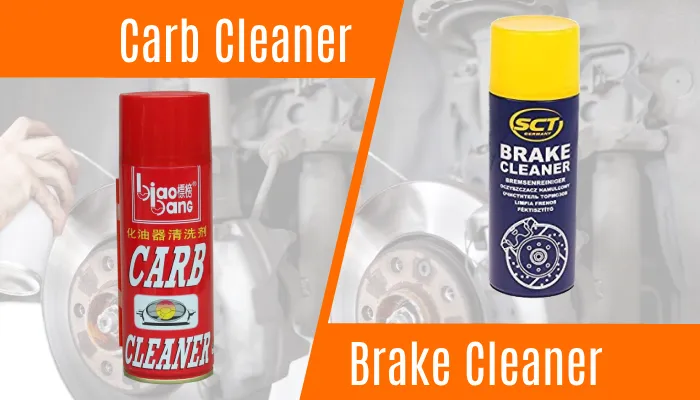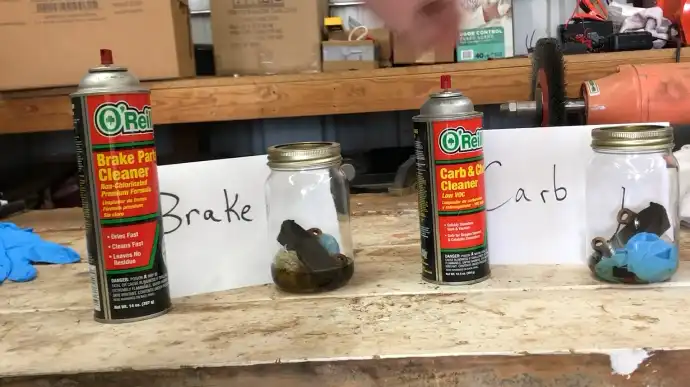Physical Address
304 North Cardinal St.
Dorchester Center, MA 02124
Physical Address
304 North Cardinal St.
Dorchester Center, MA 02124

Carb and brake cleaners are two commonly used cleaning agents in the automotive industry. If you’re a car enthusiast or a DIY mechanic, you’re likely familiar with these indispensable products.
While carb and brake cleaners may seem quite similar at first glance, there are some critical differences that every vehicle owner or maintenance enthusiast should be aware of.
Carb cleaner, as the name suggests, is designed to clean carburetors and remove stubborn contaminants from them. On the other hand, brake cleaner is specifically intended to clean brake components and ensure safe and effective braking.
We’ll talk about the differences between carb cleaner and brake cleaner in more detail so you’ll know when to use them and how they can help.

Carb and brake cleaners differ in several key aspects. Here are five notable differences between these two essential cleaning products.
Carb cleaner and brake cleaner differ in their chemical composition. Carb cleaner typically contains acetone, heptane, toluene, and carbon dioxide, while brake cleaner shares these ingredients but includes methanol.
The addition of methanol allows brake cleaner to evaporate rapidly, leaving behind very little residue after cleaning. Methanol also impacts the brake cleaner’s ability to dissolve contaminants, making it a more effective cleaner for brake components.
Regarding their primary purposes, carb and brake cleaners serve distinct roles in maintaining the performance and functionality of different automotive components.
Carb cleaner is specifically designed to clean carburetors, which are responsible for the precise mixture of fuel and air in the combustion chamber.
Over time, varnish, dirt, and debris can accumulate in the carburetor, hindering its function. Carb cleaner effectively removes these contaminants, restoring the carburetor’s ability to mix fuel and air accurately.
In contrast, brake cleaner is intended for cleaning brake components such as discs, calipers, pads, and other parts of the braking system. It’s crucial to keep the brakes clean and free from any contaminants to ensure safe and effective braking.
Even a small amount of residue can significantly impact the performance of the brakes. Brake cleaner is specifically formulated to remove grease, oil, brake fluid, and other substances that can compromise the braking system’s efficiency.
The chemical reaction, oil content, and residue differ between carb and brake cleaners.
Since carb cleaner does not contain methanol, it tends to leave behind a film after use. This film acts as a protective layer, deflecting particles and reducing future build-up in carburetors. However, it may not be suitable for applications where a clean, residue-free finish is required.
Carb cleaner contains oil and leaves an oily residue after drying, which can extend the lifespan of seals and gaskets but isn’t ideal for surfaces that need to be oil-free, such as brake components.
In contrast, brake cleaner, which contains methanol, evaporates quickly, leaving a cleaner, almost residue-free surface. It’s formulated to be oil-free and doesn’t leave any residue, ensuring optimal brake performance and safety.
To understand the differences in material compatibility between carb cleaner and brake cleaner, it’s important to consider which parts these cleaners can safely be used on.
Carb cleaner is generally more forgiving when it comes to material compatibility. It can be safely used on rubber, neoprene, and vinyl materials, which are commonly found in carburetors. The formulation of carb cleaner is designed to protect these materials, including gaskets and rubber seals, which are prevalent in carburetor components.
On the other hand, brake cleaner isn’t as universally compatible with a wide range of materials. It can potentially harm rubber, plastics, and electrical components, making it essential to exercise caution when using it on these parts.
Some formulations of brake cleaner may not be suitable for cleaning plastic or rubber components, as they can cause damage or deterioration.
Brake cleaner is generally more versatile than carb cleaner and can be used to clean various mechanical parts beyond just brakes. Its quick-drying and residue-free properties make it suitable for various applications where cleanliness and precision are crucial.
It can effectively remove dirt, grease, oil, and other contaminants from surfaces such as engine components, transmission parts, and even electrical connections.
Meanwhile, carb cleaner is primarily designed for cleaning carburetors and smaller engines like those found in lawnmowers and snowblowers. Due to its residue-forming characteristics, it’s less versatile for general cleaning tasks.
Therefore, if you require a cleaner with broader applications and the ability to remove stubborn contaminants, brake cleaner would be the more suitable choice.
| Aspect | Carb Cleaner | Brake Cleaner |
| Chemical Composition | Acetone, heptane, toluene, carbon dioxide | Acetone, heptane, toluene, carbon dioxide, methanol |
| Primary Purpose | Designed for cleaning carburetors | Intended for cleaning brake components |
| Chemical Reaction, Oil Content, and Residue | Leaves a film to deflect particles, may contain oil | Evaporates rapidly, leaving a cleaner, almost residue-free surface |
| Versatility | Primarily for carburetors and smaller engines | More versatile, suitable for various mechanical parts |
| Material Compatibility | Compatible with rubber, neoprene, and vinyl materials | Not universally compatible, may harm rubber, plastics, and electrical components |

Regarding cleaning carburetors, there are two types of carb cleaners available: chlorinated and non-chlorinated. Chlorinated carb cleaner is more potent and dries quicker, making it ideal for deep-cleaning carburetors.
However, it can be toxic and should not be used for plastic components. Meanwhile, non-chlorinated carb cleaner is less toxic and slower to dry, making it safer for use on plastic components.
For brake components, there are also two types of brake cleaners available: chlorinated and non-chlorinated. Chlorinated brake cleaner is highly effective at removing contaminants from brake components but can harm certain materials.
Conversely, non-chlorinated brake cleaner is a safer option for plastics and rubber but dries more slowly. Therefore, it’s vital to choose the right type of cleaner based on your specific cleaning needs and the materials involved. This will ensure a successful and safe cleaning process.
When cleaning automotive components, it’s important to remember that carb and brake cleaners shouldn’t be used interchangeably. These two cleaning products have different formulations and purposes, making them unsuitable for each other’s intended tasks.
The carburetor cleaner is specifically designed to clean carburetors and other engine components, leaving a slight oil residue to protect rubber seals and gaskets.
Meanwhile, brake cleaner is formulated to clean brake components, such as pads and rotors, and it’s designed to leave no residue to maintain optimal brake performance.
Using carb cleaners on brake components can potentially damage the braking system, and using brake cleaners on engine components may not provide the necessary lubrication and protection.
Therefore, it’s crucial to choose the appropriate cleaner for each specific automotive component to ensure safety and efficiency.
To use brake cleaner effectively for cleaning your vehicle’s brakes, start by lifting your vehicle and removing the wheels to access the brake components. Apply the brake cleaner thoroughly to various parts like discs, drums, pads, and calipers.
After application, wipe off any excess cleaner to ensure a clean surface. It’s crucial to clean all four wheels, even if dust buildup is visible only on specific wheels. Always wear protective gear such as a mask, safety glasses, and gloves while applying the cleaner to safeguard yourself.
Both carb and brake cleaners are essential tools in the automotive maintenance arsenal. They may share some common ingredients, but their unique formulations and purposes set them apart.
Carb cleaner, with its residue-forming characteristics, is perfect for cleaning carburetors and smaller engines, safeguarding delicate components.
Meanwhile, brake cleaner’s rapid evaporation and residue-free properties make it the go-to choice for maintaining brake components and ensuring safe, efficient braking.
The use of these cleaners interchangeably is not recommended. Each has its distinct role, and choosing the right one for the task at hand is crucial.
So, whether you’re revitalizing your carburetor or ensuring your brakes are in top-notch condition, always use the appropriate cleaner for best results.